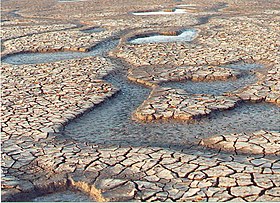
Mudcracks (also known as mud cracks, desiccation cracks or cracked mud) are sedimentary structures formed as muddy sediment dries and contracts. [1] [2] Crack formation also occurs in clay-bearing soils as a result of a reduction in water content.

Mudcracks (also known as mud cracks, desiccation cracks or cracked mud) are sedimentary structures formed as muddy sediment dries and contracts. [1] [2] Crack formation also occurs in clay-bearing soils as a result of a reduction in water content.


Naturally forming mudcracks start as wet, muddy sediment dries up and contracts. A strain is developed because the top layer shrinks while the material below stays the same size. When this strain becomes large enough, channel cracks form in the dried-up surface to relieve the strain. Individual cracks spread and join up, forming a polygonal, interconnected network of forms called "tesselations." If the strain continues to build, the polygons start to curl upwards. This characteristic can be used in geology to understand the original orientation of a rock. [3] Cracks may later be filled with sediment and form casts over the base.[ citation needed ]
Syneresis cracks are broadly similar features that form from underwater shrinkage of muddy sediment caused by differences in salinity or chemical conditions, [1] rather than aerial exposure and desiccation. Syneresis cracks can be distinguished from mudcracks because they tend to be discontinuous, sinuous, and trilete or spindle-shaped. [4]
Mudcracks are generally polygonal when seen from above and v-shaped in cross section. The "v" opens towards the top of the bed and the crack tapers downward. Allen (1982) proposed a classification scheme for mudcracks based on their completeness, orientation, shape, and type of infill. [4]
Complete mudcracks form an interconnected tessellating network. The connection of cracks often occurs when individual cracks join together forming a larger continuous crack. [4] Incomplete mudcracks are not connected to each other but still form in the same region or location as the other cracks. [4]
Orthogonal intersections can have a preferred orientation or may be random. In oriented orthogonal cracks, the cracks are usually complete and bond to one another forming irregular polygonal shapes and often rows of irregular polygons. In random orthogonal cracks, the cracks are incomplete and unoriented therefore they do not connect or make any general shapes. Although they do not make general shapes they are not perfectly geometric. [5] Non-orthogonal mudcracks have a geometric pattern. In uncompleted non-orthogonal cracks they form as a single three-point star shape that is composed of three cracks. They could also form with more than three cracks but three cracks in commonly considered the minimum. In completed non-orthogonal cracks, they form a very geometric pattern. The pattern resembles small polygonal shaped tiles in a repetitive pattern. [4]
Mud curls form during one of the final stages in desiccation. Mud curls commonly occur on the exposed top layer of very thinly bedded mud rocks. When mud curls form, the water that is inside the sediment begins to evaporate causing the stratified layers to separate. The individual top layer is much weaker than multiple layers and is therefore able to contract and form curls as desiccation occurs. [5] If transported by later currents, mud curls may be preserved as mud-chip rip-up clasts.
Naturally occurring mudcracks form in sediment that was once saturated with water. Abandoned river channels, floodplain muds, and dried ponds are localities that form mudcracks. [6] Mudcracks can also be indicative of a predominately sunny or shady environment of formation. Rapid drying, which occurs in sunny environments, results in widely spaced, irregular mudcracks, while closer spaced, more regular mudcracks indicate that they were formed in a shady place. [7] Similar features also occur in frozen ground, lava flows (as columnar basalt), and igneous dykes and sills. [8]
Polygonal crack networks similar to mudcracks can form in human-made materials such as ceramic glazes, paint film, and poorly made concrete. Mudcrack patterning at smaller scales can also be observed studied using technological thin films [9] [10] deposited using micro and nanotechnologies. [11]
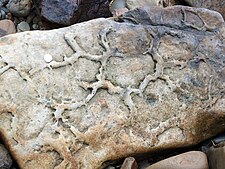
Mudcracks can be preserved as v-shaped cracks on the top of a bed of muddy sediment or as casts on the base of the overlying bed. When they are preserved on the top of a bed, the cracks look as they did at the time of formation. When they are preserved on the bottom of the bedrock, the cracks are filled in with younger, overlying sediment. In most bottom-of-bed examples, the cracks are the part that sticks out most. Bottom-of-bed preservation occurs when mudcracks that have already formed and are completely dried are covered with fresh, wet sediment and are buried. Through burial and pressure, the new wet sediment is further pushed into the cracks, where it dries and hardens. The mudcracked rock is then later exposed to erosion. [2] In these cases, the original mud cracks will erode faster than the newer material that fills the spaces. This type of mudcrack is used by geologists to determine the vertical orientation of rock samples that have been altered through folding or faulting. [12]

Sedimentary rocks are types of rock that are formed by the accumulation or deposition of mineral or organic particles at Earth's surface, followed by cementation. Sedimentation is the collective name for processes that cause these particles to settle in place. The particles that form a sedimentary rock are called sediment, and may be composed of geological detritus (minerals) or biological detritus. The geological detritus originated from weathering and erosion of existing rocks, or from the solidification of molten lava blobs erupted by volcanoes. The geological detritus is transported to the place of deposition by water, wind, ice or mass movement, which are called agents of denudation. Biological detritus was formed by bodies and parts of dead aquatic organisms, as well as their fecal mass, suspended in water and slowly piling up on the floor of water bodies. Sedimentation may also occur as dissolved minerals precipitate from water solution.

Wadi, alternatively wād, Maghrebi Arabic Oued, is the Arabic term traditionally referring to a river valley. In some instances, it may refer to a wet (ephemeral) riverbed that contains water only when heavy rain occurs.

In structural geology, a fold is a stack of originally planar surfaces, such as sedimentary strata, that are bent or curved ("folded") during permanent deformation. Folds in rocks vary in size from microscopic crinkles to mountain-sized folds. They occur as single isolated folds or in periodic sets. Synsedimentary folds are those formed during sedimentary deposition.
A way up structure, way up criterion, or geopetal indicator is a characteristic relationship observed in a sedimentary or volcanic rock, or sequence of rocks, that makes it possible to determine whether they are the right way up or have been overturned by subsequent deformation. This technique is particularly important in areas affected by thrusting and where there is a lack of other indications of the relative ages of beds within the sequence, such as in the Precambrian where fossils are rare.
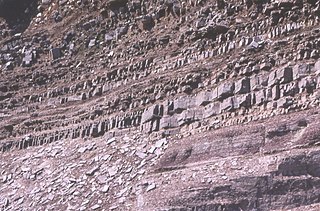
In geology, the term Torridonian is the informal name for the Torridonian Group, a series of Mesoproterozoic to Neoproterozoic arenaceous and argillaceous sedimentary rocks, which occur extensively in the Northwest Highlands of Scotland. The strata of the Torridonian Group are particularly well exposed in the district of upper Loch Torridon, a circumstance which suggested the name Torridon Sandstone, first applied to these rocks by James Nicol. Stratigraphically, they lie unconformably on gneisses of the Lewisian complex and their outcrop extent is restricted to the Hebridean Terrane.
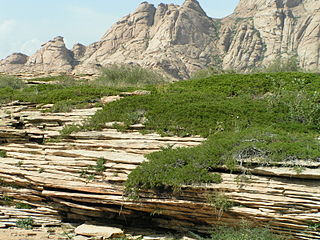
A joint is a break (fracture) of natural origin in a layer or body of rock that lacks visible or measurable movement parallel to the surface (plane) of the fracture. Although joints can occur singly, they most frequently appear as joint sets and systems. A joint set is a family of parallel, evenly spaced joints that can be identified through mapping and analysis of their orientations, spacing, and physical properties. A joint system consists of two or more intersecting joint sets.
An overbank is an alluvial geological deposit consisting of sediment that has been deposited on the floodplain of a river or stream by flood waters that have broken through or overtopped the banks. The sediment is carried in suspension, and because it is carried outside of the main channel, away from faster flow, the sediment is typically fine-grained. An overbank deposit usually consists primarily of fine sand, silt and clay. Overbank deposits can be beneficial because they refresh valley soils.

In geology, cross-bedding, also known as cross-stratification, is layering within a stratum and at an angle to the main bedding plane. The sedimentary structures which result are roughly horizontal units composed of inclined layers. The original depositional layering is tilted, such tilting not being the result of post-depositional deformation. Cross-beds or "sets" are the groups of inclined layers, which are known as cross-strata.

Sole marks are sedimentary structures found on the bases of certain strata, that indicate small-scale grooves or irregularities. This usually occurs at the interface of two differing lithologies and/or grain sizes. They are commonly preserved as casts of these indents on the bottom of the overlying bed. This is similar to casts and molds in fossil preservation. Occurring as they do only at the bottom of beds, and their distinctive shapes, they can make useful way up structures and paleocurrent indicators.

In geology, a bed is a layer of sediment, sedimentary rock, or volcanic rock "bounded above and below by more or less well-defined bedding surfaces". Specifically in sedimentology, a bed can be defined in one of two major ways. First, Campbell and Reineck and Singh use the term bed to refer to a thickness-independent layer comprising a coherent layer of sedimentary rock, sediment, or pyroclastic material bounded above and below by surfaces known as bedding planes. By this definition of bed, laminae are small beds that constitute the smallest (visible) layers of a hierarchical succession and often, but not always, internally comprise a bed.
Cyclic sediments are sequences of sedimentary rocks that are characterised by repetitive patterns of different rock types (strata) or facies within the sequence. Processes that generate sedimentary cyclicity can be either autocyclic or allocyclic, and can result in piles of sedimentary cycles hundreds or even thousands of metres thick. The study of sequence stratigraphy was developed from controversies over the causes of cyclic sedimentation.

In geology and geomorphology, a tessellated pavement is a relatively flat rock surface that is subdivided into polygons by fractures, frequently systematic joints, within the rock. This type of rock pavement bears this name because it is fractured into polygonal blocks that resemble tiles of a mosaic floor, or tessellations.

Sedimentary structures include all kinds of features in sediments and sedimentary rocks, formed at the time of deposition.

Lenticular bedding is a sedimentary bedding pattern displaying alternating layers of mud and sand. Formed during periods of slack water, mud suspended in the water is deposited on top of small formations of sand once the water's velocity has reached zero. Lenticular bedding is classified by its large quantities of mud relative to sand, whereas a flaser bed consists mostly of sand. The sand formations within the bedding display a 'lens-like' shape, giving the pattern its respected name. They are commonly found in high-energy environments such as the intertidal and supratidal zones. Geologists use lenticular bedding to show evidence of tidal rhythm, tidal currents and tidal slack, in a particular environment.
The Triassic Lockatong Formation is a mapped bedrock unit in Pennsylvania, New Jersey, and New York. It is named after the Lockatong Creek in Hunterdon County, New Jersey.
A dish structure is a type of sedimentary structure formed by liquefaction and fluidization of water-charged soft sediment either during or immediately following deposition.

Syneresis cracks are a sedimentary structure developed by the shrinkage of sediment without desiccation – not to be confused with desiccation cracks. Syneresis is the expulsion of a liquid from a gel-like substance. Syneresis cracks are formed by the contraction of clay in response to changes in the salinity of a liquid surrounding a deposit. The cracks can occur, for example, in mudstones deposited between two beds of sandstone. The markings would have been formed subaqueously on the bedding surface and could resemble desiccation mudcracks, but are not continuous and vary in shape. They commonly occur in thin mudstones interbedded with sandstones, as positive relief on the bottom of the sandstone, or as negative relief on the top of the mudstone. Subaqueous shrinkage cracks can develop on and through a surface that has been continuously covered in water. Syneresis cracks in some shales and lime mudstones may initially be preserved as small cavities, which then usually fill with silt and sand from either the overlying or underlying beds and laminae. Usually there is no pattern to the cracks, and they do not connect to form geometric shapes. Rather they are discontinuous and shaped in one of the following categories:

Soft-sediment deformation structures develop at deposition or shortly after, during the first stages of the sediment's consolidation. This is because the sediments need to be "liquid-like" or unsolidified for the deformation to occur. These formations have also been put into a category called water-escape structures by Lowe (1975). The most common places for soft-sediment deformations to materialize are in deep water basins with turbidity currents, rivers, deltas, and shallow-marine areas with storm impacted conditions. This is because these environments have high deposition rates, which allows the sediments to pack loosely.
Heterolithic bedding is a sedimentary structure made up of interbedded deposits of sand and mud. It is formed mainly in tidal flats but can also be formed in glacial environments. Examples from fluvial environments have been documented but are rare. Heterolithic bedding forms in response to alternations in sediment supply and tidal velocity. The fluctuations result in the interbedded layers of sand and mud. The rippled sand layer is formed during high tidal currents, while the mud is deposited during slack tide periods. The three main types of heterolithic bedding are flaser, wavy, and lenticular. Starved ripples and cross bedding with flasers can also be considered forms of heterolithic bedding. Differentiating of these various types of heterolithic bedding is based on the relative volume of mud and sand. This key determining factor is controlled by the timing, and duration of both the high tide, and slack tide depositional periods.
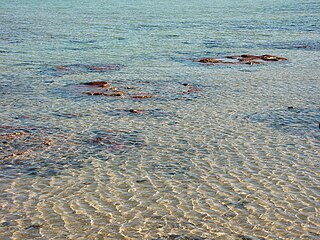
Shallow water marine environment refers to the area between the shore and deeper water, such as a reef wall or a shelf break. This environment is characterized by oceanic, geological and biological conditions, as described below. The water in this environment is shallow and clear, allowing the formation of different sedimentary structures, carbonate rocks, coral reefs, and allowing certain organisms to survive and become fossils.